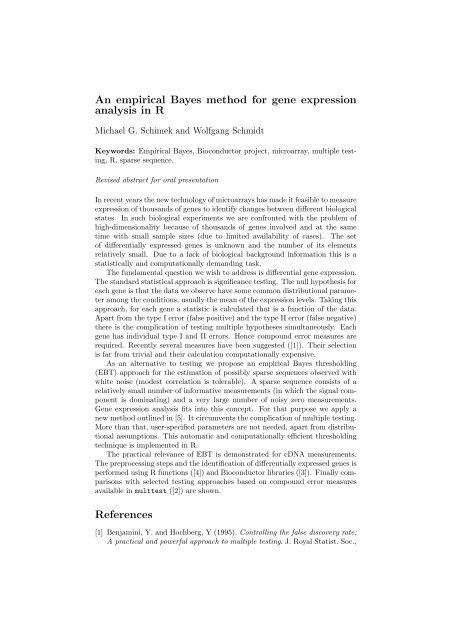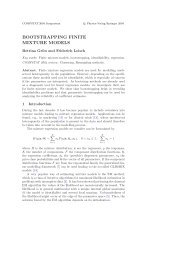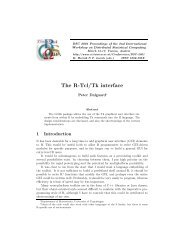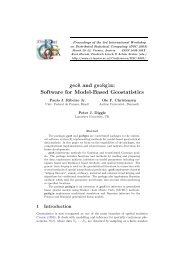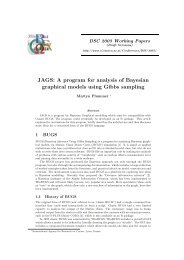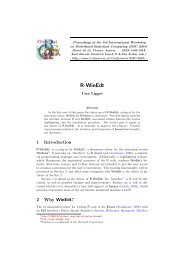Embedding R in Windows applications, and executing R remotely
Embedding R in Windows applications, and executing R remotely
Embedding R in Windows applications, and executing R remotely
You also want an ePaper? Increase the reach of your titles
YUMPU automatically turns print PDFs into web optimized ePapers that Google loves.
An empirical Bayes method for gene expression<br />
analysis <strong>in</strong> R<br />
Michael G. Schimek <strong>and</strong> Wolfgang Schmidt<br />
Keywords: Empirical Bayes, Bioconductor project, microarray, multiple test<strong>in</strong>g,<br />
R, sparse sequence.<br />
Revised abstract for oral presentation<br />
In recent years the new technology of microarrays has made it feasible to measure<br />
expression of thous<strong>and</strong>s of genes to identify changes between different biological<br />
states. In such biological experiments we are confronted with the problem of<br />
high-dimensionality because of thous<strong>and</strong>s of genes <strong>in</strong>volved <strong>and</strong> at the same<br />
time with small sample sizes (due to limited availability of cases). The set<br />
of differentially expressed genes is unknown <strong>and</strong> the number of its elements<br />
relatively small. Due to a lack of biological background <strong>in</strong>formation this is a<br />
statistically <strong>and</strong> computationally dem<strong>and</strong><strong>in</strong>g task.<br />
The fundamental question we wish to address is differential gene expression.<br />
The st<strong>and</strong>ard statistical approach is significance test<strong>in</strong>g. The null hypothesis for<br />
each gene is that the data we observe have some common distributional parameter<br />
among the conditions, usually the mean of the expression levels. Tak<strong>in</strong>g this<br />
approach, for each gene a statistic is calculated that is a function of the data.<br />
Apart from the type I error (false positive) <strong>and</strong> the type II error (false negative)<br />
there is the complication of test<strong>in</strong>g multiple hypotheses simultaneously. Each<br />
gene has <strong>in</strong>dividual type I <strong>and</strong> II errors. Hence compound error measures are<br />
required. Recently several measures have been suggested ([1]). Their selection<br />
is far from trivial <strong>and</strong> their calculation computationally expensive.<br />
As an alternative to test<strong>in</strong>g we propose an empirical Bayes threshold<strong>in</strong>g<br />
(EBT) approach for the estimation of possibly sparse sequences observed with<br />
white noise (modest correlation is tolerable). A sparse sequence consists of a<br />
relatively small number of <strong>in</strong>formative measurements (<strong>in</strong> which the signal component<br />
is dom<strong>in</strong>at<strong>in</strong>g) <strong>and</strong> a very large number of noisy zero measurements.<br />
Gene expression analysis fits <strong>in</strong>to this concept. For that purpose we apply a<br />
new method outl<strong>in</strong>ed <strong>in</strong> [5]. It circumvents the complication of multiple test<strong>in</strong>g.<br />
More than that, user-specified parameters are not needed, apart from distributional<br />
assumptions. This automatic <strong>and</strong> computationally efficient threshold<strong>in</strong>g<br />
technique is implemented <strong>in</strong> R.<br />
The practical relevance of EBT is demonstrated for cDNA measurements.<br />
The preprocess<strong>in</strong>g steps <strong>and</strong> the identification of differentially expressed genes is<br />
performed us<strong>in</strong>g R functions ([4]) <strong>and</strong> Bioconductor libraries ([3]). F<strong>in</strong>ally comparisons<br />
with selected test<strong>in</strong>g approaches based on compound error measures<br />
available <strong>in</strong> multtest ([2]) are shown.<br />
References<br />
[1] Benjam<strong>in</strong>i, Y. <strong>and</strong> Hochberg, Y (1995). Controll<strong>in</strong>g the false discovery rate:<br />
A practical <strong>and</strong> powerful approach to multiple test<strong>in</strong>g. J. Royal Statist. Soc.,


